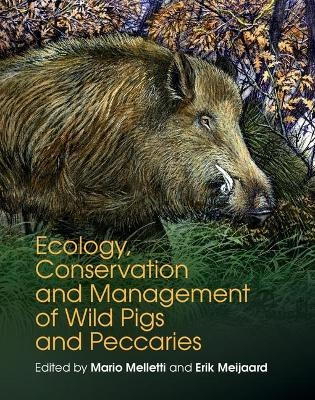
Ecology, Conservation and Management of Wild Pigs and Peccaries
Cambridge University Press (Verlag)
978-1-107-18731-3 (ISBN)
Wild pigs inhabit vast areas in Europe, Southern Asia and Africa, and have been introduced in North and South America, while feral pigs are widespread in Australia and New Zealand. Many wild pig species are threatened with extinction, but Eurasian wild boar populations, however, are increasing in many regions. Covering all wild pig and peccary species, the Suidae and Tayassuidae families, this comprehensive review presents new information about the evolution, taxonomy and domestication of wild pigs and peccaries alongside novel case studies on conservation activities and management. One hundred leading experts from twenty five countries synthesise understanding of this group of species; discussing current research, and gaps in the knowledge of researchers, conservation biologists, zoologists, wildlife managers and students. This beautifully illustrated reference includes the long history of interactions between wild pigs and humans, the benefits some species have brought us and their role and impact on natural ecosystems.
Mario Melletti is a member of the African Buffalo Initiative Group, part of the International Union for the Conservation of Nature, has studied forest buffalo for fifteen years in Central Africa and has authored three books and 45 scientific publications. Erik Meijaard is Chair of the International Union for the Conservation of Nature's Wild Pig Specialist Group. Erik is author of six books and 185 scientific papers, and a frequent writer in popular media. He has been influential in conservation policies and public opinion about them.
Foreword; Part I. Evolution, Taxonomy and Domestication: 1. Evolutionary relationships and taxonomy of Suidae and Tayassuidae; 2. Postcranial skeletal morphology in living and fossil African Suidae; 3. Diet and ecology of extant and fossil wild pigs; 4. A history of pig domestication: new ways of exploring a complex process; 5. Space, time and pig; Part II. Species Accounts: 6. Sulawesi babirusa; 7. Moluccan babirusa; 8. Togian babirusa; 9. Common warthog; 10. Desert warthog; 11. Forest hog; 12. Bushpig; 13. Red river hog; 14. Visayan warty pig; 15. Philippine warty pig; 16. Mindoro warty pig; 17. Palawan bearded pig; 18. Bearded pig; 19. Sulawesi warty pig; 20. Javan/Bawean warty pig; 21. Eurasian wild boar; 22. Pygmy hog; 23. Chacoan peccary; 24. Collared peccary; 25. White-lipped peccary; Part III. Conservation and Management: 26. Conservation of wild pigs and peccaries; 27. Modelling pygmy hog habitat to inform habitat management; 28. Introduced wild pigs in North America: history, problems and management; 29. Biological invasion of wild boar and feral pigs Sus scrofa L. (Suidae) in South America: a review and mapping with implications for conservation of peccaries (Tayassuidae); 30. Feral pigs in Australia and New Zealand: range, trend, management and impacts of an invasive species; 31. Wild boar management in Europe: knowledge and practice; 32. Resolving conflict between farmers and wild boar in Europe and in Northern Asia; 33. Human dimensions of wild boar: the need to include people in decision making processes; 34. A genomic perspective on wild boar demography and evolution; 35. Disease transmission at the interface between wild and domestic Suiform species in the Old and New World; 36. Ecological impact of wild boar in natural ecosystems; 37. Ex situ conservation of wild pigs and peccaries: roles, status, management successes and challenges; 38. Antimicrobial resistance in wild boar in Europe: present knowledge and future challenges.
| Erscheinungsdatum | 24.11.2017 |
|---|---|
| Zusatzinfo | Worked examples or Exercises; 46 Tables, black and white; 80 Plates, color; 97 Halftones, color; 95 Halftones, black and white; 58 Line drawings, black and white |
| Verlagsort | Cambridge |
| Sprache | englisch |
| Maße | 224 x 283 mm |
| Gewicht | 1600 g |
| Themenwelt | Naturwissenschaften ► Biologie ► Ökologie / Naturschutz |
| ISBN-10 | 1-107-18731-1 / 1107187311 |
| ISBN-13 | 978-1-107-18731-3 / 9781107187313 |
| Zustand | Neuware |
| Haben Sie eine Frage zum Produkt? |
aus dem Bereich


